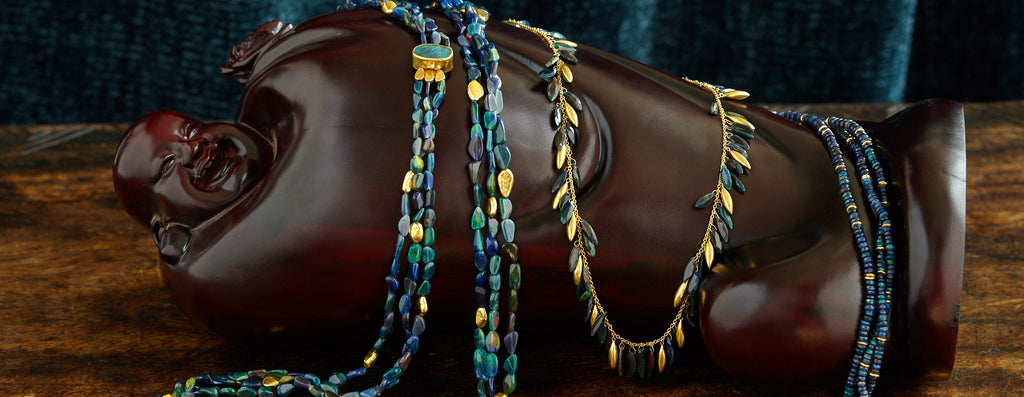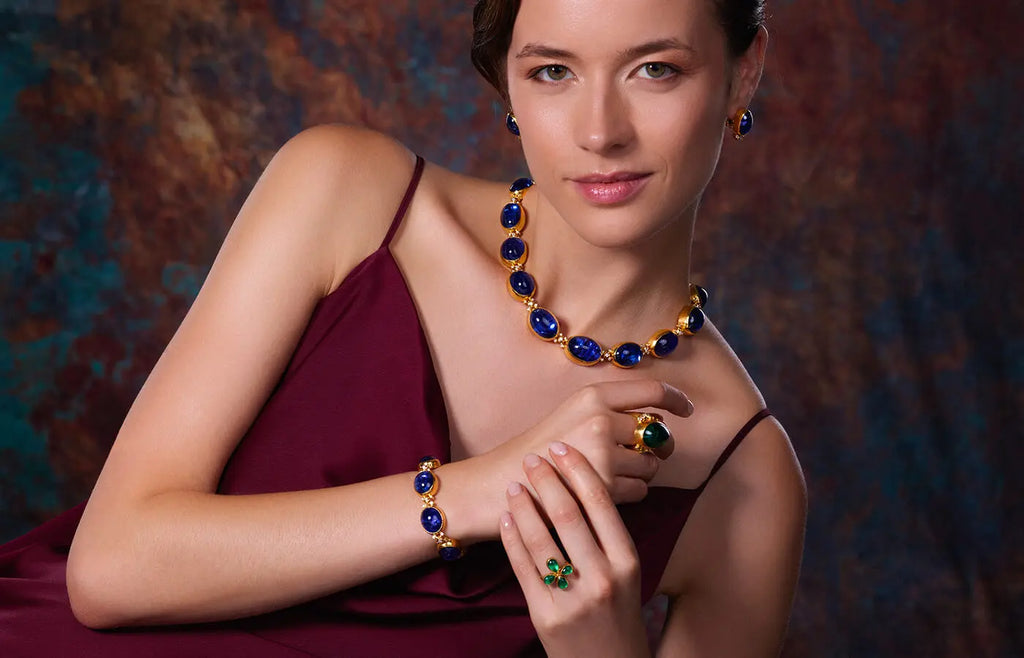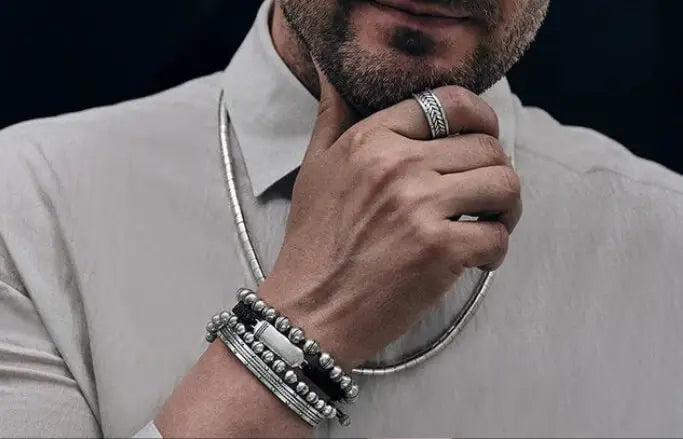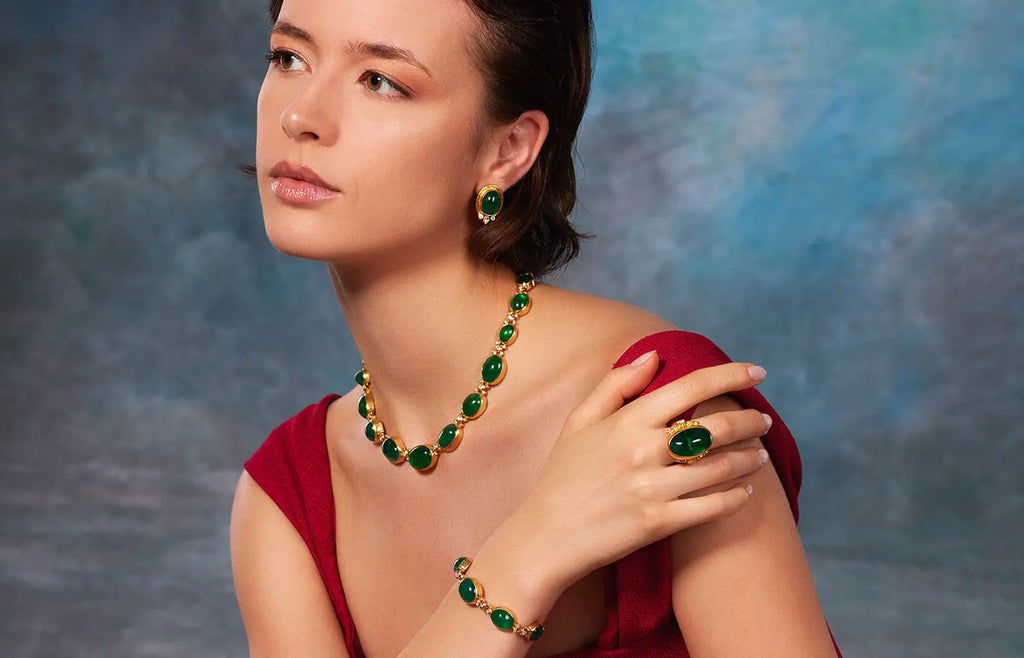" BIRTHSTONES HAVE LONG BEEN CONSIDERED DOORWAYS TO UNDERSTANDING YOURSELF. HOW YOU ASSOCIATE WITH THE QUALITIES AND MYTHS OF A BIRTHSTONE AND THE MONTH IN WHICH IT BELONGS CAN GIVE YOU GREAT INSIGHTS INTO WHO YOU ARE "
The month of October is associated with the qualities of striking seasonal change and naturally diverse color. It is only fitting that perhaps the most diverse, colorful, and mythologically inspiring gemstone—the Opal—is the birthstone for October.

Known as the “Eye Stone”, Opal is truly a feast for the eyes. Like a lightning bolt flashing in a rainbow reflected in an ocean and bouncing back into a fiery sunset, its brilliance is incomparable. This visual stunner inspires love and hope, innocence and purity, luck and happiness.
Despite unfounded superstitions that prevailed in the 19th century, Opal was redeemed in the twentieth century, and is today an absolute favorite gem, as the birthstone for those born in October, as a gift given for a 14th wedding anniversary, and as a stunning stone for anyone who just loves its extraordinary beauty and powerful qualities.
Opal is not a stone that is as widely known or as common as traditional stones like sapphire or ruby. But is favored by a number of contemporary jewelry designers, foremost among whom is GURHAN, whose opal creations are famous for the variety and quality of the stones he uses and for the wearability of the designs. Before buying opal jewelry, be sure to know what you are buying as it is a complex and fascinating stone, with an exciting history and lots of interesting myths and stories around it.

A One-Of-A Kind Stone
The Opal stone is often referred to as a “living stone”; up to 21% of it can be composed of water. In fact, this is where the Opal stone gets its many diverse colors, because light reflects off the air and water trapped within the stone fissures formed over centuries. The hydration comes from rain that forces a substance known as Silica down into deep layers of rock; after years of natural heating of the earth’s surface, the rain evaporates and the resulting substance is Opal stone.
Opal is classified as a mineraloid (not crystallized), due to its amorphous quality. This amorphous and unpredictable quality has come to be known as one of its most defining features as no two Opals are the same and many of them (classified as “precious” Opals) come in a tremendous variety of playful and iridescent color schemes. “Common” Opal stones do not play with color in the way that the “precious” ones do, but they come in a range of solid colors and are prized for their luminosity and relatively soft texture.
Where Opal Birthstones Come From
Since the discovery of Opals in 19th century in Australia most of the world’s current supply comes from there. So perhaps it is fitting that the Dreamtime legends of the Australian aborigines tell that when the Creator came down to Earth on a to bring a message of peace to all humankind, at the very spot where his foot touched the ground, the stones came alive and began to sparkle in all the colors of the rainbow, and this was the birth of Opals.
However, a diverse range of countries are known to produce coveted varieties of this stone. These countries include Ethiopia, Mexico, the Czech Republic, Brazil, Honduras, and even the United States.

Choosing Opal Birthstones
There are a wide variety of names used to describe different types of Opal stones. That said, there are three basic categories of Opals: Precious, Common and Fire Opal. Within each of these categories there are many types of Opals.
Precious Opal
Also known as “Rainbow Opal,” precious opals are the most expensive and rarest, mined in a limited number of locations worldwide. They produce brilliant flashes or streaks of iridescent color when turned in the light. The color is not due to pigment in the stone, but are optical effects created when light passes through microscopic spheres of silica and diffracts to break up into the colors of the spectrum. The size of the spheres and their pattern determines the color and quality of the diffracted light, and the value of the Opal.
There are quite a few varieties of Precious Opal and each is very distinctive.
- Black Opal – the black base of this Opal acts as a canvas for the one-of-a-is covered up entirely. The majority of Black Opals come from Lightning Ridge, New South Wales, Australia and are the most famous and sought-after Opals in the world. “Black Opal” can look like everything from a gemstone stolen off a sorcerer’s staff to entire galaxies captured within the confines of a few millimeters.
- Boulder Opal, an Opal variety of striking artistic potential, is found only in Queensland, Australia. These Opals are still attached to their host rocks and because the Opal veins are quite thin, it is cut with the stone left on the back for support or as layers of Opal within the matrix stone. Mined in Queensland, Australia, each finished piece is unique and special.
- White Opal – this form of Precious Opal is probably the best-known of the Opals and commonly used in jewelry. It has a light body color, usually white, yellow or cream, with a rainbow flash of color. The majority of White Precious Opal comes from Australia, most notably the town of Coober Pedy, nicknamed “Opal Capital of the World.”
- Crystal Opal – one of our favorites, this transparent to semi-transparent Precious Opal, possesses an exceptional play of color. Because it is see-through, it is often set against a dark backing to allow the colors to shine through. It ranges in colors from violet blue to brilliant turquoise and aqua-tones and has flashes of reds, yellow, greens, oranges and pinks. GURHAN is particularly fond of this stone and it is the dominant stone used in his renowned Opal Jewelry collections.
- Ethiopian Opals are a more recent entry into the market and as Australian Opals have become scarcer and more valuable, Ethiopian Opals have become a viable alternative to their Australian cousin. Ethiopian Opals are hydrophane Opals that forms in volcanic ash. It occurs in a variety of colors and patterns and usually displays brilliant flashes of color ranging from cream, to orange, to blue. GURHAN has started using Ethiopian Opals in recent years as the variety of cuts and colors have become more enticing. Despite some bad press regarding their stability, the new Opals from the Welo district of Ethiopia discovered in 2008 have proven to be extremely stable despite their porosity, able to absorb water and change transparency or opacity, then revert back to their original state with no adverse reaction or cracking. Ethiopian opals which are a dark black or brown color have probably been treated with smoke to color.
- Matrix Opal - Precious Opal interspersed within a host rock, usually ironstone or sandstone, where the Opal occurs as a network of veins or an infilling of pore spaces; usually displays “pinfire” color in the natural state. The most famous Matrix Opal comes from Australia, most notably from Andamooka as well as Queensland. Honduras Black Opal is also a Matrix Opal of basalt sought after for its black body color and pinfire flashes.
- Wood Opal and Opalized Nature - Precious Opal which has become fossilized over time by partially replacing the organic portions of tree, plant or animal remains; these formations have been found in dinosaur bones, marine creatures, in bogs, as limb casts, or within wood structures, at times still forming the trees’ original growth rings. GURHAN uses some of these fascinating stones in some of his most interesting designs.
Common Opal
Found in many places throughout the world it forms with spheres of unorderly sizes or stacking, and does not exhibit play of color. It usually has a milky or pearly luster, known as “opalescence.” GURHAN uses these opals in his Silver Jewelry designs.
- Andean Opal or Peruvian Opal - Common Opal from the Andes Mountains of Peru; translucent to opaque, soft pastel blue, blue-green or pink with a pearly sheen, sometimes cut to include the black or beige matrix in the more opaque stones.
- Potch Opal - found in many locations around the world it is generally opaque and does not exhibit play of color. It forms in nearly all colors, has a lustrous sheen, and can be cut into gemstones that accept a high polish.
- Moss Opal or Dendritic Opal - milky white to brownish Common Opal with dark-green moss, tree or fern-like inclusions (dendrites) of various silicates, hornblende or manganese oxides; shows no play of color.
- Green Opal and Prase Opal - green varieties of Common Opal, the first being a mixture of Opal and nontronite, the second being Opal containing nickel.
- Milk Opal – this is cloudy Opal with a light background. Milk Opals were called the milk drops of the Mother Goddess in a number of cultures.
- Water Opal or Hyalite - colorless, water-clear Common Opal with no play of color, formed in grape-like clusters or otherwise unusual shapes; also known as Muller’s Glass.
- Fire Opal is a transparent to translucent Opal with a body color of vivid red, orange or yellow, most commonly mined in Mexico. It typically shows no play of color, though occasionally a stone will have a weak display or exhibit bright green flashes. If a stone exhibits iridescent flashes it is referred to as Precious Fire Opal, or “Firmament Stone”.
Something to be on the lookout for with all Opals is the difference between solid opals and doublets or triplets which are far less valuable.
- Solid Opal refers to complete stones consisting wholly of Precious Opal,
- Doublets and triplets are thin layers of opal that are fixed to a supportive backing, and in the case of triples, a crystal dome over the top for protection.
FAMOUS OPALS

Highly treasured Opals include the “Eternal Flame.” The “Eternal Flame” is the largest precious Black Opal stone in the world; it sits at 568 carats and is appropriately named for its intense and sublime color scheme that unapologetically provokes awe in the beholder. The largest and most highly valued Opal stone in general, the Olympic Australis, sits at 17,000 carats and is valued at $1.9 million.
OPALS IN HISTORY
The Origin of the Opal is associated with cultures as diverse as India and Greece. The first Opals brought to the West are thought to come from India—where the Sanskrit word Upala, meaning “a precious stone,” was used to refer to the stone. The Romans changed that word to Opalus; the English Opal comes directly from the Greek Opallos, which literally means “to see a change;” the term refers to the vast range of color the Opal stone can reflect. The Romans produced the first known market for Opals. This important empire wanted a stone to resemble their wealth and status, and they favored the bright color plays of Opals over single color gems such as diamonds or pearls.
When Emperor Napoleon offered his Empress Josephine an Opal stone with a hue dazzling with flashes of red so prominent that he described them as the “Burning of Troy,” he knew that only a stone so unique in nature was worth handing to his wife.
It is said that Mark Antony loved Opals for the way they reminded him of his nights with Cleopatra. And when he offered to buy one from the Roman senator Nonius, he granted Nonius only one other option—death. Nonius preferred to flee to exile with nothing in his possession but his life and his precious Opal stone. One Roman emperor offered to trade one third of his lands for a single precious stone. At the time, most of the Opal supply to the Romans was coming from Hungary, where Opal production today is virtually non-existent.
Luckily, Opal production pops up in various parts of the world. The oldest known collection of Opals comes from a cave in Kenya; this collection is thought to date back as early as 4,000 B.C.; these Opals are supposed to have originated in Ethiopia, where Opals were not rediscovered until 1990 A.D.
During the Crusades, ladies gave their crusaders an Opal to bring them good fortune in battle, and Opals were often placed upon the navel of an expectant mother to provide ease in childbirth. Blonde maidens in Germany and Scandinavia were said to value nothing more highly than necklaces of Opals and pins for their hair, for they added magical luster to their golden locks, and as long as they wore these, their hair kept its beautiful color.
In the 19th Century, Queen Victoria’s love of Opals led her to champion an Australian, Herbert Bond, who made the 19th century discovery of Opals in Australia and attempted unsuccessfully to establish a market for them in London. Queen Victoria noticed his efforts and blessed him with a lease to the first Opal mine in Queensland, Australia—the largest mine of its time.
It took another ten years before Opals became popular in England, but eventually they were so popular that they began to outsell Diamonds; as a result, Diamond sellers began circulating what eventually became a very powerful superstition that the Opal stone is bad luck. This superstition continues to haunt the Opal industry despite thousands of years of extremely positive spiritual and mythological associations with the stone.
The “bad luck” of the Opal stone that was popularized by jealous Diamond sellers had its basis in a novel called Anne of Geuerstein, written by Sir Walter Scott in 1829. The novel centers around Lady Hermione, a woman falsely accused of being a demon who dies shortly after a drop of holy water destroys the color of an Opal in her possession. Walter Scott’s popularity as a novelist, coupled with the Diamond industries determination to attack their new rival was enough to virtually destroy the Opal industry in England for at least half a century. And the resulting superstition towards Opals continues to linger even in our time. In an article just this last week the author, a jewelry aficionado, admitted her ‘silly superstition!’
https://www.jckonline.com/editorial-article/opal-superstition/
THE POWER OF OPALS
In truth, the Opal stone is supported by thousands of years of nearly worship-worthy associations.
- The ancient Romans called the Opal stone the queen of gems and associated it with purity, hope, and truth.
- In the 14th century in Europe it was believed the Opal stone had a quality to ward off evil and to strengthen one’s sight.
- In India, the place that introduced the Opal stone to Europe, it was believed that by passing an Opal stone across one’s brow one could enhance memory and clear the mind of excess thoughts. Thus, the Opal stone has a meditative quality.
- The ancient Bedouins believed the stone was formed through divine flashes of lightening.
- Greeks believed the Opal stone had the power to ward off disease.
- Greek astrologers and spiritual mediums honored the Opal for its ability to open the mind to visions and they used them in prophecy and for divination.
- Both the indigenous Australian aboriginal shamans and the Native American Indians utilized them in ceremonial “dreamtime” to invoke vision quests.
- During the Middle Ages, an amulet made with Opal was believed to protect its wearer against faulty vision, while strengthening the mind and memory.
- In Medieval times, Opal was considered to be a talisman that would allow its owner to recognize his friends and enemies. In the presence of an enemy, the Opal would grow pale, but in the presence of friends or allies it would turn red with pleasure.
If you are into self-examination and transformation, just as Opal absorbs and reflects light, it picks up thoughts and feelings and can surface a person’s traits and characteristics. Both negative and positive attributes are magnified and enhanced by Opal allowing the wearer to let go the negative and foster the positive.
Opal is known as a ‘transformer crystal’. These crystals enhance attempts to change our circumstances, prospects, health, perspective or relationships. By transforming ourselves we transform our lives. We learn to sing, dance, a new language, become stronger, or become a better person. What a beautiful stone if it can help us to grow, develop our capabilities and change our lives.
Love, romance, happiness, confidence, faithfulness, successful child birth, battle-ready strength, artistic expression—the Opal stone is believed to promote health in all of these areas, along with many others. Indeed, just looking into the many different colors of an Opal and discovering the ways that its color can shift against light might just do the trick for anyone looking to ease the craziness of our modern existence!
CARING FOR OPALS
Due to its relatively high water content and its relative softness (it has a hardness range of 5 to 6.5 on the Mohs scale), the Opal is a delicate stone that can become damaged under high temperature, dehydration, and light. Protect this “living gem” from the withering affects of heat, harsh chemicals, excess soap and water, and hard materials. Gemstones that can damage the Opal stone if brought into close proximity include diamonds, rubies, sapphires, and emeralds, among other hard stones.
Use warm, lightly soaped water on a soft cloth to clean. The best care you can offer an Opal is to wear often, as the exposure to moisture will help preserve the stone.
WEARING OPALS

People drawn to the Opal stone tend to have a maverick quality about them. Indeed, the Opal stone symbolizes a certain uniqueness and an unflinching break from the mold. As a maverick designer himself, it is not surprising that GURHAN is a leader in Opal jewelry design. His unprecedented creativity and insistence on hand-crafting enhances the stones magic, love, and adventurous essence.
Just as the Greeks believed—if your heart is in the right place, the Opal stone can give you a power and a thirst for existence beyond your wildest imagination. So, this month, allow the powers of change, diversity, and beauty to take hold and gift yourself or a loved one a truly precious stone.







